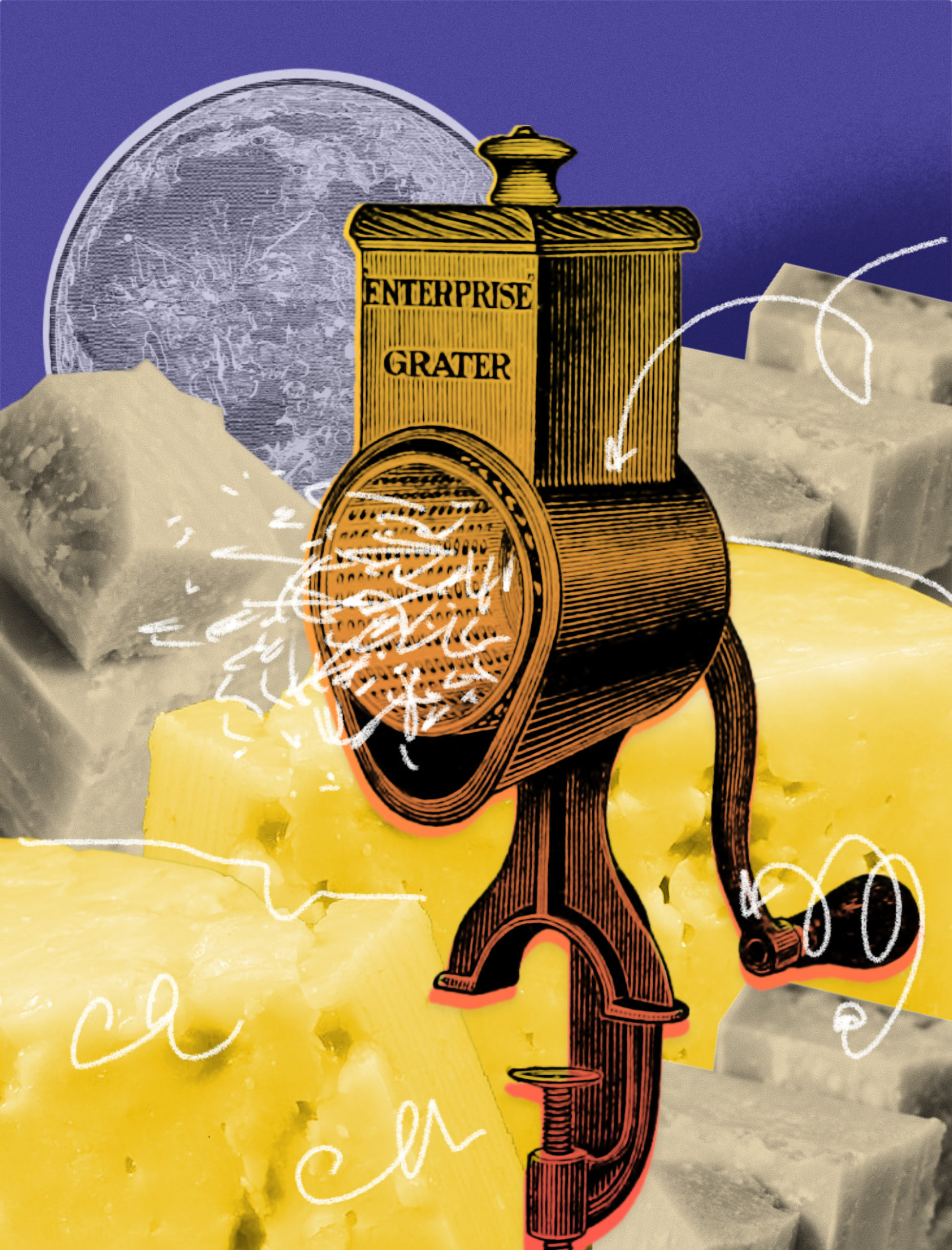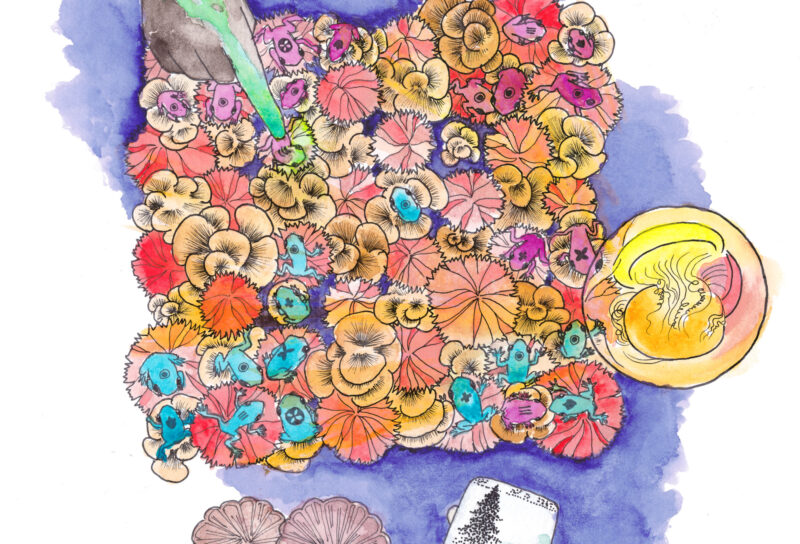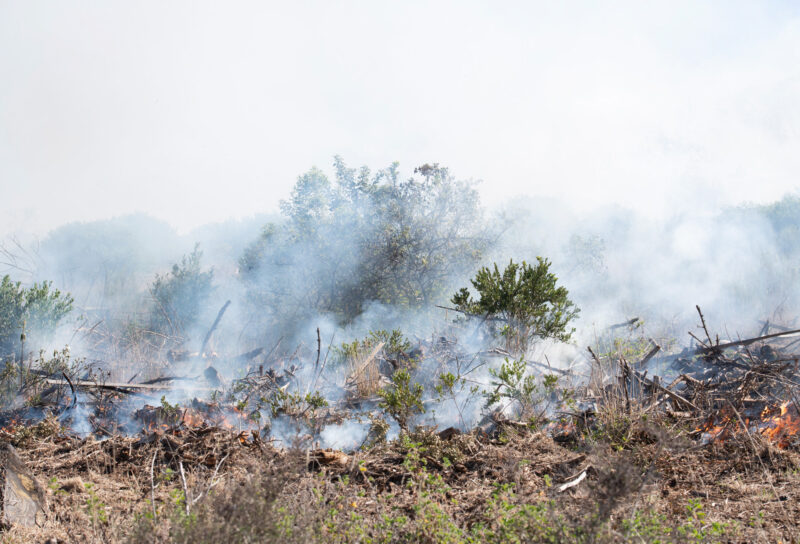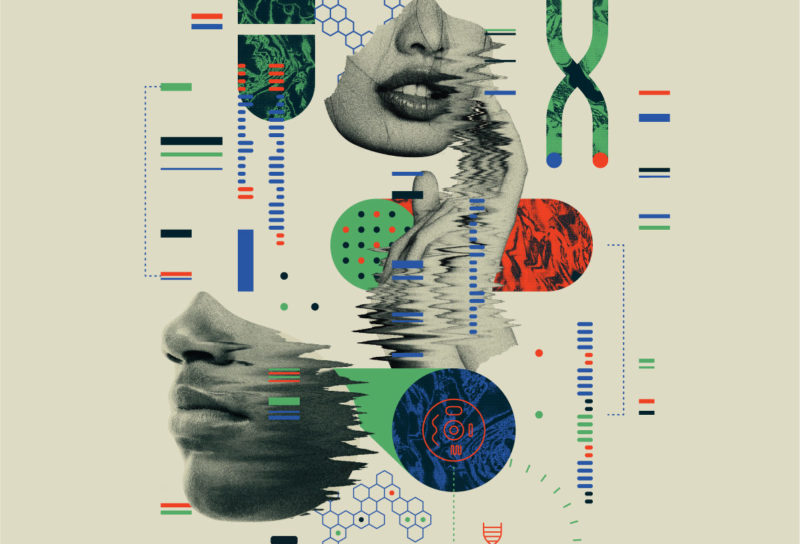Adapted from the Gastropod episode, Who Faked My Cheese? co-produced and co-hosted by Cynthia Graber and Nicola Twilley.
Maria Chavez is an aspiring vegan, and there’s only one thing stopping her: she LOVES cheese. “I’m a member of the team that is holding out for a really good cheese to take me all the way,” she says. Many cheese-lovers are on that same trajectory, whether they’re concerned about animal welfare, trying to limit their carbon footprint, or simply can’t digest the stuff. This increasingly common conundrum begs the question: why is it so hard to make a convincing — and genuinely loveable — cheese substitute? What intricacies have to be mastered, and how far are we from getting it right?
Obviously, you can’t replicate something without carefully studying the original. This brings us to some larger questions about cheese. What is it, actually? How is it made? And what makes it so delicious? The meltiness, the texture, the sharpness and funk, the famous creamy mouth-coating awesomeness — it turns out, there are scientific explanations for them all.
The Science of Cheese
Last summer, we spent a morning in an Italian parmesan-making school watching a master cheese-maker turn fresh milk into glorious wheels of cheese. He started off with 580 liters of milk, which looked so fresh that we both felt the strong urge to bathe in it. Milk is the essential ingredient. For real Parmesan like this, the cheese-maker has to use raw milk from local grass-fed cows. Kantha Shelke, a food scientist at Corvus Blue, says that most of what we love about cheese comes from the milk itself. “It’s a concentrate of nutrients. These nutrients are very important when making cheese. It needs that sugar — that lactose, fat, and protein, that extra water with a number of different salts.”
Our parmesan-maker heated up the milk in huge copper tubs, added a bucket of whey, which he and his colleagues saved from yesterday’s cheese batch, and then added rennet, an enzyme that comes from the animal’s stomach. It’s fascinating to contemplate: making cheese means literally recreating the conditions in a calf’s belly. A baby cow turns its mother’s milk into soft cheese inside its stomach, because cheese passes through its digestive system more slowly than milk, giving the calf more time to absorb all its nutrients.
The milk hardened into solid lumps in front of our eyes. These are the micelles at work, globules of casein proteins that attract water molecules. This process is what makes milk a liquid in the first place — without it, the water and protein and fats would all separate. It’s what makes milk, milk, and it’s the magic sauce that makes cheese, cheese.
Our cheesemaker reached into the tub; apparently these parmesan-makers have the softest hands in Italy. He lay each clot of sponge-like parmesan into its own cheesecloth. From here, these clots take a trip in a special cheese elevator that drops them off in a brining pool. They will be spending at least a month here — all the salt helps control the microbes in the cheese. Then they are shipped off to a cheese cave, where they grow old together. Once in a while, the cheese-makers look in to gently tap on the parmesan wheels to see how it’s aging. The parmesan is losing moisture, the proteins are moving around and forming a crystal structure, and the salt is penetrating very, very slowly all the way through the cheese.
A cheese’s age determines its structure. In a fresh, un-aged cheese, the protein molecules are large and stretchy — they tend to get tangled into ropes, and so they stay very loosely fit. But if the salt and microbes are given a long time to act on the cheese as it ages, the casein gets broken down, the proteins are smaller, they’re no longer so tangled up. This is the difference between parmesan, an old cheese which is hard to melt, and a young cheese like mozzarella, which literally melts in your mouth. That’s the science behind all these unique textures and flavors. These delightful qualities — all of which depend on casein — are the reasons we love cheese.
Remaking Cheese from Scratch
But how do you do any of that without the magic ingredient? Miyoko Schinner, the head of a vegan cheese company called Miyoko’s Creamery, has been wrestling with that question since a dairy allergy rendered her beloved cheese platters off-limits. She joked that the only readily available replacement she found in the mid-90s, Veganrella, practically made her throw up. The options have since drastically improved. And yet nature has made it almost impossible to find a slam-dunk replacement for lactose, for casein, and for the fat in milk. Of course, that hasn’t stopped people from trying.
Fermented tofu is the oldest example of a cheese alternative. Of course, it wasn’t created for that purpose — it was just interpreted that way once it was eaten by a cheese-loving European. In 1855, the French consul in Shanghai, Baron de Montigny, wrote a report on “this Chinese cheese,” a “very powerful appetizer, which is hard to resist.” It isn’t hard to see how the baron made the connection. Fermented tofu is a soft, creamy, salty, cheese-like food that is believed to have originated somewhere in China or Japan. Some forms have very strong aromas that are reminiscent of, say, a mold-ripened cheese, like roquefort or brie or stilton or gorgonzola. Others are very mild and creamy, almost like a neufchatel. Schinner’s first experiments with vegan cheese involved burying tofu underground in a miso or ash marinade, a technique she saw used by Japanese nuns on TV. This transforms the texture from crumbly to buttery and smooth. The only problem: tofu doesn’t melt.
In the early 2000s, Schinner noticed that some raw food enthusiasts were making cheese out of nut milk and fermenting it with microbes. The concept of making cheese out of nuts is an old one that comes from the Middle East and India, where nuts were used to create creamy desserts. Nuts have a lot less protein than milk and they have no casein-like protein, so it takes a lot more skill and manipulation to be able to get that rich creamy mouthfeel and the flavors and textures that one expects from the traditional cow’s milk cheese.
To get the flavor right, Schinner decided that she needed to experiment with microbes to work their particular magic. She started inoculating her nut cheeses with microbes and aging them; developing the process required a lot of trial and error. “They can develop all sorts of flavors. The cultures can work over a period of weeks or months,” Schinner said. “I can have a cheese — for example, one of our Mount Vesuvius black ash cheeses — and it can taste one way. Two weeks after I’ve aged it, and even after packaging it will continue to age. If I taste it around a year later, it’s phenomenal.”
Whale Cheese
In Northern California, meanwhile, two labs are collaborating to produce real cheese proteins without animals. They are trying to create cheese from casein produced by genetically modified yeasts. “What if we use yeast?” Maria Chavez, a member of the Real Vegan Cheese project, recalls founder Marc Juul’s eureka moment. “What if we have it produce cheese proteins instead of alcohol?” This started them down a new path of experimentation. “We created a process very similar to beer brewing, with a few extra steps to actually make cheese that is biologically, chemically identical to the kind you get from a cow.”
It turns out that it’s not so simple to just take the genes that make casein in a cow and stick them in yeast. It requires a lot of tweaking for the genes get comfy in an organism that comes from an entirely unrelated branch of life. Even when the yeasts are able to make milk proteins, it’s tough to get yeast-based technologies to scale up. Sometimes yeast in a huge vat doesn’t behave the same as it does in a petri dish.
It’s the magic sauce that makes cheese, cheese.
But that hasn’t stopped the Real Vegan Cheese team from dreaming big. They’re not stopping at cow’s milk cheese, either. Their next project happened to be human cheese — adding the genes that make milk in humans to yeast. The team thought that a human-milk cheese would be better suited to people who can’t process cow’s milk, as it might not cause allergies or other dairy intolerances.
“We discovered two different things,” Chavez said. “One: people have almost zero interest in a human cheese. They’re actually quite disgusted by it, for whatever reason. And that kind of surprised us because we thought it was kind of cool.” Secondly, Chavez told us, the FDA weren’t fans, either, and argued that human proteins might trigger an autoimmune response. So, no human-milk microbial cheese.
Their third idea was the most ambitious. “We wanted to take most ridiculous, really unusual organism that people have never made cheese from,” Chavez said. “And when we thought, what has no one ever milked to make cheese from that’s a mammal? And we thought narwhal whales. Whale milk is very similar to toothpaste — a textural identity that might indicate a unique protein structure.”
Everything the Real Vegan Cheese project does is open source, so anyone can get involved. The bigger idea — their real goal — is to open up the science of synthetic biology and get people comfortable with it. After all, there’s been quite a lot of push-back and concern in the general public about genetically-modified organisms, particularly when it comes to food.
Their cheese, she says, “is a genetically engineered product. You aren’t eating the genetically engineered yeast, but the end result is made from a GMO. That changes people’s perceptions of GMO foods.” As it happens, most people don’t know that the rennet in a lot of the normal dairy cheese in the supermarket today was produced by genetically modified fungi. Maria believes we can use this technology for good—it’s not all big evil corporations selling us Frankenfoods. She wants others to see that potential, too.
Exploring the science of vegan cheese has given us an appreciation for the majesty of the real thing. It took our ancestors thousands of years to perfect the craft, replicating the workings of a calf’s stomach. Perhaps we just need a bit of time to remove the animal from the equation altogether.



